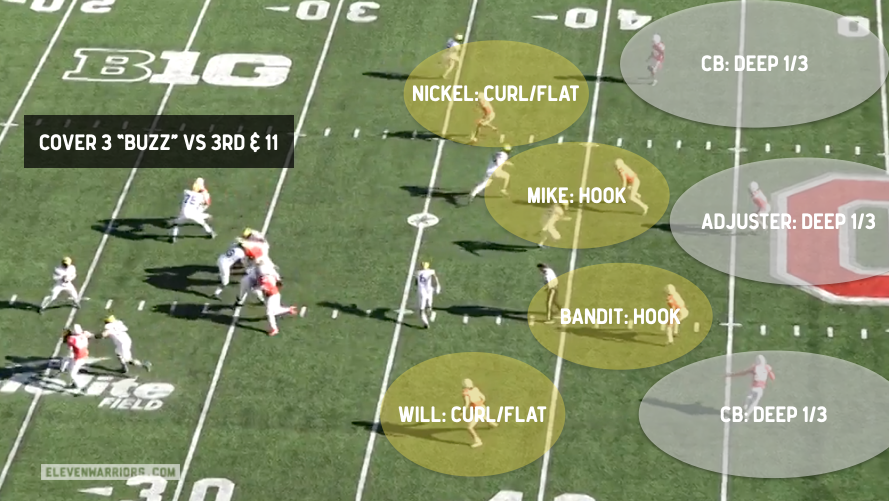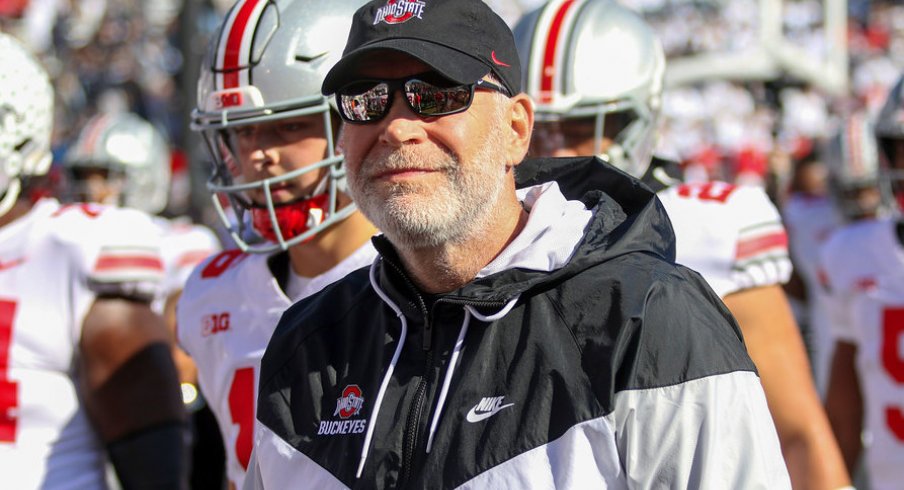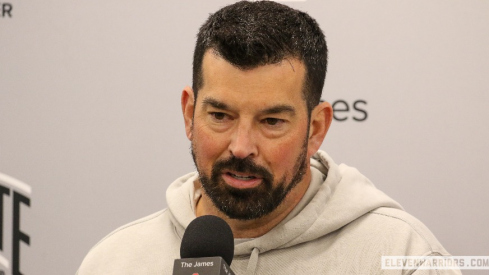Once again, 2022 was supposed to be The Year in Columbus.
Ohio State returned a Heisman finalist at quarterback, a loaded cast of skill players, and two NFL-caliber tackles on offense. All they needed was for their counterparts on defense to NOT be a total mess, as had been the case in 2021.
This wasn't asking a lot, after all. Rarely had championship teams featured elite units on both sides of the ball, and the defense simply needed to be good enough to let those superstars on offense shine brightly.
Enter Jim Knowles. The veteran coach emerged from anonymity after turning Oklahoma State into one of the nation's best defenses one year ago, instantly making him the biggest fish in a pond of defensive coordinator candidates.
The Cowboys finished in the top five of virtually every statistical category in 2021 despite featuring a cast of relative nobodies, so it was no wonder that many expected Knowles to do wonders with all the talent sitting inside the WHAC. But lost in those conversations was the idea of what Knowles would actually DO with all those blue-chip bodies awaiting his instruction.
Fast forward to today, and some Buckeye fans are feeling buyer's remorse after watching a coordinator making $2 million annually give up 1,063 combined yards in the final two (and most important) contests of the 2022 season, both of which resulted in painful OSU losses. As a result, the narrative surrounding Knowles' impact has been skewed, leading to many questions about what to expect from his defense moving forward.
First and foremost, we should all acknowledge that what Knowles' defense showed this season was not a duplicate of his efforts in Stillwater.
“We didn't do everything that we did at Oklahoma State," said safety Tanner McCalister last week, who played four seasons for Knowles before following him to Columbus as a graduate transfer. "But also the conference is a little different as well. So there are certain things that we did up at Oklahoma State that he may not install at Ohio State. But yeah, we definitely couldn't do everything. So there's definitely still things that he has in his bag that maybe he'll bring out.”
It's also worth noting that McCalister was the only significant newcomer to a unit that returned eight starters along with a number of backups that had seen significant playing time the year before. That meant that Knowles' first task was identifying ways for these same players to be put in a position to succeed after having struggled the year before.
The easiest way to accomplish that task was by disguising his intentions before the snap. After the Buckeyes largely sat in a static, singe-high shell for three seasons, Knowles brought a variety of looks to the secondary in hopes of confusing opponents.
The safety trio of McCalister at Nickelback (field), Ronnie Hickman at Adjuster (middle), and Lathan Ransom at Bandit (boundary) took on more of a burden than any other position within the unit, allowing the eight other defenders to have fewer responsibilities on any given snap. As Knowles admitted in both spring and fall camp, the entire system largely depended on these three players and their ability to execute more complex assignments than had been asked of them in the past.
No more are Buckeye safeties expected to only drop 30 yards into the middle of the field and read the eyes of the quarterback. Instead, they might be asked to do that one play, line up in the box and fill the C-gap against the run on the next snap, and blanket a slot receiver in man-coverage the play after that. Rather than make one player specialize in each of those tasks, Knowles switches up their assignments from play to play in order to keep the opposing offense guessing and not allow them to attack any one tendency or matchup, as often happened under the previous regime.
But the irony is despite all this disguise and movement in the secondary, the Buckeye defense largely relied on the same basic schemes as they had in the past few years. While Tampa 2 zone and 3-deep zone-match coverages were more prevalent in each week's game plan, the Ohio State defense continued to be a Cover 1 (man-free) team at heart.
While many (including this writer) looked forward to seeing more variety in coverages from Ohio State this past season, the reality is the unit was actually very good at executing the concept. Not only were Buckeye defensive backs comfortable shadowing opponents downfield, but Knowles' interpretation asked the safeties to handle the misdirection and option elements of opposing run games that gave the program fits in recent years.
The result was a simplified approach for the defensive line and linebackers that allowed them to focus on stuffing inside run gaps while the safeties worked together to handle action on the edges.
This type of teamwork not only required a versatile skill set but outstanding preparation, anticipation, and communication from the OSU safeties. For the most part, the Buckeyes had no issue executing this scheme throughout the season and often relied upon it in high-leverage situations.
Of course, some of the unit's biggest failures also came when in this coverage. While covering Georgia receiver Arian Smith in man-to-man, Ransom gave up a 76-yard touchdown after falling down, allowing the Bulldogs to make the Peach Bowl a one-score game in the fourth quarter.
By then, such mistakes had become all too familiar for Ohio State fans who became all too accustomed to seeing the Buckeyes give up big plays last season, especially when Ransom was involved. The junior finished third on the team in tackles and did an excellent job in man coverage against three of the nation's best tight ends in Notre Dame's Michael Mayer, Iowa's Sam LaPorta, and Georgia's Brock Bowers, living up to his high billing as a recruit.
A player possessing all the tools to play the position, Ransom was rarely caught out of position while playing for his third coordinator in as many seasons as a Buckeye. But despite performing well against the All-America and All-Big Ten selections at tight end, he also gave up a 25-yard gain on the very first play of the game when manned up against Maryland's CJ Dippre.
Ransom wasn't fooled or caught out of position on this delayed screen pass, nor was he caught in the wash of blockers releasing downfield. No, Ransom simply missed the tackle, allowing Dippre to rumble ahead for a first down that brought the crowd in College Park to its feet.
By the season's end, many began to conflate fundamental mistakes like these with schematic decisions made by the new coordinator. However, the threat of surrendering an explosive play was always in effect with Knowles at the helm, as his style of play-calling at Oklahoma State was of the high-risk/high-reward variety.
Early in the season, this approach earned high praise as the constant blitzes that left defenders on islands in man coverage always seemed to work. In the opener against Notre Dame, midway through the year at Penn State, and all the way up to the penultimate regular season contest at Maryland, Knowles found success by sending six-man pressures with the secondary in straight man-to-man coverage with no safety help. More often than not, these schemes forced sacks or throw-aways in big third-down situations and forced the opposing punt team to trot out onto the field.
The Buckeyes were one of the best in the nation at quickly getting off the field this season thanks to this approach, giving up the fourth-fewest first downs per game among all FBS defenses, averaging just 15 first downs surrendered per contest. Compared to the year prior, when the Buckeyes gave up 21.3 first downs per game (tied for 78th nationally), this was a massive improvement, as it meant the Buckeye defense was getting the ball back in the hands of C.J. Stroud and the potent OSU offense more often.
However, the flip side of that 'all-or-nothing' equation meant that while the Buckeyes gave up the sixth-fewest plays of 10+ yards last season, they were one of the worst at giving up really big plays. Only five teams in FBS gave up more plays of 50+ yards last season when Ohio State gave up 11 such gains, with five of those plays coming against Michigan and Georgia.
Some may think it's reckless for Knowles to call for so many risky blitzes, especially with a team prone to missing open field tackles or slipping in coverage. But it's worth noting that he doesn't do it as often as people think.
Everyone remembers the all-out blitz in the second quarter against Michigan. You know, the one where Cam Brown missed a tackle and Cornelius Johnson ran 60 yards for the Wolverines' first touchdown. The one that seemed to symbolize the 'don't bend, just shatter' approach that many have criticized.
But on the drive right before that one, the Buckeyes had also forced Michigan into a 3rd & long situation. However, on that occasion, Knowles didn't send the house. Instead, he elected to run a soft, Cover 3 zone that resulted in an incomplete pass sailing over the head of the receiver.

Knowles' goal is not to make his players masters of one specific concept, but rather to have enough options on his call sheet to stay one step ahead of the opposing play-caller, and that means occasionally taking risks. For the 2022 Buckeyes, those risks were magnified by a secondary that had far too many failures in technique, rather than scheme.



